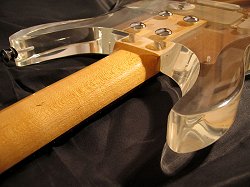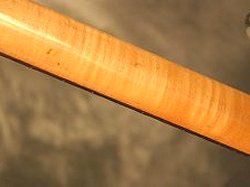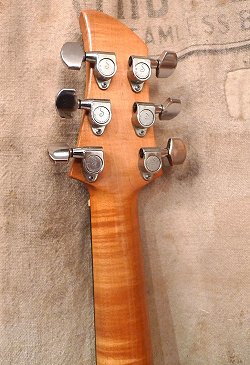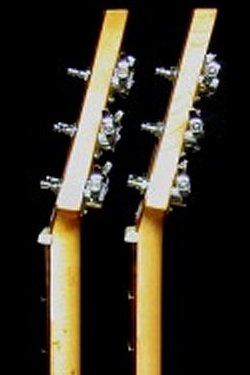
According to Steve Constantelos, one of Ampeg's design engineers, the guitar necks for the Dan Armstrong instruments
were made right in the Ampeg factory under the supervision of Pete 'Buddy' Tuscano - who was a wood specialist as well
as Manager of the Instrument Division at Ampeg. He involved himself in everything from the grade of wood coming into
the factory to the final finishing touches before the instrument left the factory. In an interview Jeese Keeler of Death
From Above he verified Steve's statement saying "I learned from someone who worked there [Ampeg] that they were making
the necks by hand". He finished stating "I was scared about short scale not being deep enough, but thatís not a problem."

|
Once in the assembly area, each Dan Armstrong instrument was fitted with a neck that is as innovative as the
body, and were built from quarter-sawn northern maple.
Matt Umanov relates the story, stating "when building the prototypes for Dan, I recommended the use of
quarter-sawn maple. Dan didn't really have much knowledge about such things as wood grain and how it affects structure,
strength, and tone. But he took my advice unquestioningly after I gave him a brief explanation and demonstration."
|
The existance of quarter-sawn over plain-sawn maple is just one small example of the high quality
materials used on these instruments and a testament to the high quality standards that Matt used on the prototypes and
that Dan insisted on throughout the entire production run. When it comes to guitar necks quarter-sawn wood is what
'separates the men from the boys' for it provides improved stability, with much, much less shrinkage, warping &
twisting than plain-sawn wood, and northern maple provides for maximum sustain when bolted to the acrylic body.

|
A unique effect of quarter-sawn wood is that it can sometimes present us with a dramatic appearance. The grain on the
face of quarter-sawn wood has tight, straight, parallel lines running the length of the board and if the tree rings
happened to be very close to 90° perpendicular to the face of the wood then the effect of the ring can be seen
when turned to a light source.
In the case of Oak the effect is referred to as 'Quartered Oak'. When it comes to maple it is often referred to as
'Flame-Maple'.
|

|
On Gibson's Les Paul sunburst guitars the effect can often be seen on their maple tops creating the look that
somewhat resembles the backside of a violin or cello.
On certain models the effect is very dramatic and when turned
toward a light source a certain way the flame is so vibrant that it takes on the look of a tiger's pelt, and is often
referred to as a 'flame-top' or 'tiger-stripe'.
The existance of flame-maple necks on Dan Armstrong instruments were sporadic at best, for the quarter-sawn
maple was used for it's stability over appearance. While flame-maple is no less, or more stable than non-flame, it is
nevertheless a treat to discover it, and to know that it can only come from quarter-sawn lumber.
|

|
Earlier models have thicker necks on them, similar to a Les Paul Standard while later models have
necks that are thinner, more like a Les Paul Deluxe.
The neck on the left has a serial number of A204D making it a very early 1969 model, while the number
on the right has a serial number of A2357D R which dates it around a later 1970 model. One can clearly
see the thickness of the neck on the earlier model. When asked, Dan replied "I just felt that the necks were a bit
too big, and so we changed over to a thinner neck." When the change occurred is unknown, but the best guess, based
on serial numbers, is that it was the early part of 1970.
Ampeg literature states that the thickness of the neck is the same at the 24th fret as it is at the first fret. To
test this I unbolted these two necks from their bodies and one by one I inserted the squared base end of the neck
into my shop vise to hold the neck in place while I took some measurements.
|
Upper left - taking multiple measurements of the first fret on the 1969 model neck with the serial number
A204D yielded a thickness of 0.915" or 23.26mm. The width of the neck measured in at 1.774" or
45.08mm. But by the 12th fret, as can be seen in the upper right, the measurement had moved down to 0.907" or
23.05mm. The width measured in at 2.045" or 51.96mm.
Upper left - by the 23rd fret it snuck down to 0.891 or 22.63mm. Measurements at the 24th fret were
not possible to retrieve as it was too close to the shop vise. Moreover, the neck at the 24th fret area was just
starting to give up it's nicely rounded shape in preparation of the change from the curved back to the squared shape that makes
up the tongue which gets inserted and resides within the acrylic body. The width of the neck was now 22.18" or 56.35mm. On the 24th fret
the width measured in at 2.234" or 56.74mm.
As to whether the Ampeg literature was correct or not is debatable. Technically speaking, the caliper proves that the
neck is not quite "the same thickness at the 24th fret as it is at the 1st fret." Instead, it would seem that
the neck is the thickest at the first fret, and narrows down as one goes up the neck. But on the other account it is
worth mentioning that the variances that were measured are so minimal that short of using a caliper and taking
measurements like this one would never notice the difference, nor would they consider such minor changes a 'difference' to speak
of had they known. For all intents and purposes, it could be argued that the literature is correct, and that the neck
is roughly the same throughout.
Next, I wanted to compare a newer neck to the older one. As can be seen upper right, I placed the neck from my 1970
Dan Armstrong with the serial number A2357D R into my shop vise and placed the caliper on the first
fret. What I discovered proved to be most interesting. Again taking multiple measurements, the neck measured in at
0.802" or 20.37mm. Considerably thinner than the 69 neck which came in at 0.915" or 23.26mm. The width of the neck
came in at 1.641" or 41.69mm.
At the 12th fret, as seen upper left - things got interesting. I had expected the neck to be like the 69 neck - thinner
by a small amount over the first fret. Instead, the neck got thicker and I had to move my caliper out to slide it on.
Hardly believing my eyes, I took several more measurements, as the neck measured in at 0.856" or 21.74mm. The neck width
at the 12th fret was 2.010" or 51.07mm.
By the time I got to the 23rd fret, upper right - I once again had to take several more measurements than what I had
been taking prior as the neck at this point came in at 0.892" or 22.68mm. Even thicker yet, over the 12th fret. The
width of the neck at the 23rd fret was 2.220" or 56.40mm. and 2.232" or 56.71mm at the 24th fret.
I immediately began to wonder if the changing thickness of this neck was the reason that it was stamped as a
reject when in fact it plays so well, so I decided to measure another newer neck. This time I measured the neck
on my 1971 Dan Armstrong guitar with the serial number A2678D which exhibited the same results.
While it is true that Dan had "changed over to a thinner neck" it is also apparently true that the necks were
given a completely new profile over the older necks. While the old necks remained fairly constant, the newer necks
began thin and got thicker as one went up the neck.
In my interview with Matt Umanov, he stated "I intentionally made the prototype guitar neck wider at the nut, and
therefore at the 24th fret too (as well as string spacing at the bridge) than any standard electric guitar of the
day, and probably a bit wider than standard steel-string acoustics of the day as well. The depth, or thickness from
fingerboard surface to back of neck, was pretty much left alone, thereby giving more of a 'flat-oval' feel to the neck.
This, from my recollection, of Danny's usual reply of "do what you think is best" when I asked him what he wanted for
neck dimensions and string spacing on the prototype."
As a point of reference, I took width measurements off the neck of my Dan Armstrong 1969 and 1970 guitar models.
1969 Dan Armstrong
1st Fret: 1.774" or 45.08mm
12th Fret: 2.045" or 51.96mm
23rd Fret: 2.218" or 56.35mm
|
1970 Dan Armstrong
1st Fret: 1.641" or 41.69mm
12th Fret: 2.010" or 51.07mm
23rd Fret: 2.220" or 56.40mm
|
Given these readings, it would appear that Ampeg's 1969 production neck was a bit wider than the 1970 model until one gets to the upper registers of neck. At that point
the 1970 model was just a bit wider by a small fraction.
Moving to the bass guitar neck - and as seen at left, the width at the first fret on my 1970 Dan Armstrong bass measures in at 1.633" or 41.402mm.
At right, the neck thickness omes in at 0.899" or 22.8346mm.
At left, by the twelveth fret, the width moved up to 1.938" or 49.2252mm while on the right, the neck thickness reads in at 0.9285" or 23.5712mm.
At the last fret the neck widens a bit more, measuring in at 2.238" or 56.8452mm while the neck thickness moves up to 0.984" or 24.9936mm.
continue
menu
Names and images are TMand © Dan Armstrong / Ampeg. All rights reserved.
All other names and images are TMand © of their respective owners. All rights reserved.
|
| |

